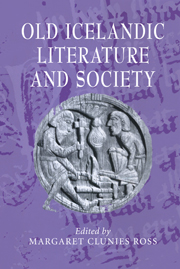Book contents
- Frontmatter
- Contents
- List of contributors
- Introduction
- 1 Social institutions and belief systems of medieval Iceland (c. 870–1400) and their relations to literary production
- 2 From orality to literacy in medieval Iceland
- 3 Poetry and its changing importance in medieval Icelandic culture
- 4 Óláfr Þórðarson hvítaskád and oral poetry in the west of Iceland c 1250: the evidence of references to poetry in The Third Grammatical Treatise
- 5 The conservation and reinterpretation of myth in medieval Icelandic writings
- 6 Medieval Icelandic artes poeticae
- 7 A useful past: historical writing in medieval Iceland
- 8 Sagas of Icelanders (Ílendinga sögur) and þœttir as the literary representation of a new social space
- 9 The contemporary sagas and their social context
- 10 The Matter of the North: fiction and uncertain identities in thirteenth-century Iceland
- 11 Romance in Iceland
- 12 The Bible and biblical interpretation in medieval Iceland
- 13 Sagas of saints
- Index
- CAMBRIDGE STUDIES IN MEDIEVAL LITERATURE
12 - The Bible and biblical interpretation in medieval Iceland
Published online by Cambridge University Press: 15 October 2009
- Frontmatter
- Contents
- List of contributors
- Introduction
- 1 Social institutions and belief systems of medieval Iceland (c. 870–1400) and their relations to literary production
- 2 From orality to literacy in medieval Iceland
- 3 Poetry and its changing importance in medieval Icelandic culture
- 4 Óláfr Þórðarson hvítaskád and oral poetry in the west of Iceland c 1250: the evidence of references to poetry in The Third Grammatical Treatise
- 5 The conservation and reinterpretation of myth in medieval Icelandic writings
- 6 Medieval Icelandic artes poeticae
- 7 A useful past: historical writing in medieval Iceland
- 8 Sagas of Icelanders (Ílendinga sögur) and þœttir as the literary representation of a new social space
- 9 The contemporary sagas and their social context
- 10 The Matter of the North: fiction and uncertain identities in thirteenth-century Iceland
- 11 Romance in Iceland
- 12 The Bible and biblical interpretation in medieval Iceland
- 13 Sagas of saints
- Index
- CAMBRIDGE STUDIES IN MEDIEVAL LITERATURE
Summary
The Bible is of fundamental significance in the medieval period in Iceland. Substantial parts of it were translated, in some cases more than once; passages long and short are incorporated into almost all the religious literature that has survived. This chapter will survey both the translated materials and the quotations, commenting where appropriate on the individual authors' approach to their texts.
Although the conversion of Iceland to Christianity took place at the very end of the first millennium, the earliest known translation of the entire Bible into Icelandic is that of Guðbrandur Þorláksson, which dates from 1584. Four decades earlier, Oddur Gottskálksson had translated the New Testament, which Guðbrandur incorporated largely unchanged into his work. But we know of no medieval Icelandic version of either Testament. On the other hand, parts of the Old Testament, and the historical material in the Apocrypha, were translated in the medieval period, and it is highly probable that at any rate the Gospels were too, both individually and in the form of a single harmonized version of the texts of the four Evangelists, or Gospel harmony.
The Old Testament historical material has been edited under the title Stjórn by C. R. Unger (1862): but it is not a homogeneous work, and in fact this material, covering the period from the Creation to the Exile, has come down to us in three separate and distinct versions.
- Type
- Chapter
- Information
- Old Icelandic Literature and Society , pp. 287 - 301Publisher: Cambridge University PressPrint publication year: 2000

